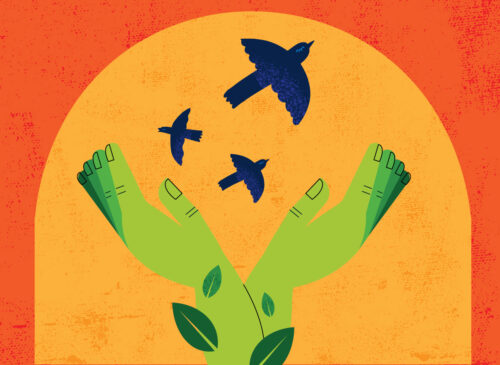For this issue, Ojibway author and journalist Tanya Talaga sat down with Victoria McMurchy from Academic Matters to discuss how Canadian postsecondary institutions have responded to the Truth and Reconciliation Commission’s Calls to Action. What needs to change for more Indigenous students to access postsecondary education and how can institutions move towards decolonization?

What was your university experience like?
My university experience was pretty good. I went to Victoria College at the University of Toronto. I commuted my first year from my home, moved into residence for my second and third year, and lived off campus in fourth year. I loved it. I was the news editor for The Strand, Victoria College’s newspaper.
It was a totally different time though in universities. I do not recall there being a First Nations presence whatsoever. When I would tell people about my background, or when they would ask me, being Ojibway was not on anyone’s radar. It was a surprise to people.
There was not very much space for Indigenous people to be honest with you. I took Canadian history, I took Canadian politics, I took the courses that were required for my degree and—other than a few passages in some of the history books concerning the fur trade—there was hardly anything about Indigenous culture or history built into the Canadian history classes we were taking. I do not recall ever learning about the Indian residential school system in my history class, or even covering the Indian Act and how racist it is. How can you leave those things out of a degree in Canadian history? But that wasn’t the focus. The focus instead was on the National Energy Program, Pierre Trudeau, and the Suez Canal Crisis. Meanwhile, we had these issues in this country that were completely ignored at university.
Meanwhile, we had these issues in this country that were completely ignored at university.
What are some of the things that you think need to change if we are to decolonize universities in Ontario and Canada?
There needs to be more Indigenous faculty hired at all universities and colleges. And the faculty that are hired have to be fairly compensated and treated just like the non-Indigenous faculty. I just saw a report from the University of Alberta that Cydney Blackstock tweeted, and it concerns how Indigenous faculty members, on average, are often paid less than non-Indigenous people. Why is that?
Beyond faculty, what about students? I think universities need to step up their outreach services by going into high schools and colleges, reaching out to First Nations, Métis, and Inuit students, and helping them out a bit. Sometimes students need the extra support in order to get into university. Get to know the communities, reach out a little bit more. As opposed to making changes to entrance and admissions requirements, go deeper than that. Go to the high schools themselves and try to bolster learning in that environment.
What are some of the systemic barriers you see Indigenous students facing when trying to access postsecondary education?
Depending on where students are coming from, some of the First Nations high schools are not seen as on par with non-Indigenous schools. What happens is that the kids have a more difficult time getting into university or they are not being let into university because the standards are different.
But that should not be happening anywhere, the standards should be the same all across the board. The standards need to the same so everyone has a fair playing field. If that is not possible, maybe there is some other way we could look at admitting First Nations kids with the skill sets that they have, which can sometimes be different than non-Indigenous kids. Look at the different courses taught at First Nations high schools and treat those courses the same as courses being tought at other Ontario high schools.
How can we address those barriers?
It’s mostly about reaching out. It is making sure that universities and colleges get to know the communities they are in and get to know the nearby nations. Just reach out. Reach out to the band council members, reach out to the local Indian friendship centres—there is actually a lot more that universities and colleges could be doing to learn about the first people in their communities. It is not that hard. The wealth of knowledge, I think, that universities would gain would really help them—especially when looking at Elders and the stories they hold.
How can mentorship or tutoring opportunities impact Indigenous youth?
I think that mentoring and tutoring students is really important because a lot of First Nations, Métis, and Inuit kids don’t come from histories, often times, where parents or grandparents went to university. Sometimes the students are flying blind when they are going into university or college. When they are applying for something, often they are the very first generation of their family to go off to postsecondary education. The change—both physical and cultural—is so different for kids coming from rural or northern communities into the city or onto a campus.
Universities need to get back to going into high schools and showing Grade 9 and 10 students what postsecondary schools can offer, what is available, and all the different career paths that are out there. You need to inspire children. By inspiring them, you will also get to know them and that is where the tutoring or mentoring can really become quite helpful. Universities will then be able to identify who needs tutoring, where the tutoring needs to happen, in what subjects, and they can be playing the part of strengthening the curriculum in high schools. To show the students that there is a place for them at universities and colleges.
How do you think the presence of Indigenous faculty would help with mentoring students?
It always helps to see yourself mirrored in other people. It would definitely help for Indigenous students to see First Nations, Métis, and Inuit professors and faculty members because it’s always going to make someone think, “I can do that too. If they are doing it, then there is a place for me here as well.”
What supports do you think Indigenous students would benefit from on campuses?
A safe place to go is always a great thing. I think Indigenous students just need to feel comfortable. It would be lovely if there was a place that said, “Hey, we know and we understand that our university is here on your land and this place is representative of you too.” And so having a special place, like a First Nations House, that people can feel like they are part of and in which they can see their culture recognised, I think, is important. Representing the culture of the First Nations of the host city also has to be very strongly represented throughout campus. This would make the university more relevant, inclusive, and welcoming.
We have seen several new university buildings, programs, and announcements focused on Indigenization but, at the same time, we have also seen a series of resignations of high-profile Indigenous university scholars. How do you think this reflects the nature of the progress being made on decolonization?
It is not an easy road. We are always going to see some trial and error going when there are going to be different visions. Universities are often stuck in this cement of “this is how we have always done things.” They cannot move. The institutions themselves, it is sometimes like trying to turn around the Titanic. That has to change, that type of thinking has to change. You know, maybe it can be done in a different way and you do not always have to do it in a way that restricts a certain point of view or others’ cultures and beliefs. Universities had not been thinking about Indigenous people when they were moving forward with their governance structures and plans. They are now, but for a long time, that was not the case.
How do you think the leadership—or the lack of leadership—at postsecondary institutions impacts both Indigenous and non-Indigenous faculty, students, and staff?
I think since the Truth and Reconciliation Commissions’ Calls to Action were put out by Murray Sinclair, institutions have taken a hard look at what they can do, especially if they are an institution of learning. The Indian Residence School experience has been left out of so much of the curriculum and so much of the basic knowledge of understanding of what has happened to this country since colonization has been left out, as an institute of learning, how can you ignore all of that? You have to understand it and also you have a job to make this country better, you have a job to make this country more inclusive, and, as an institute of higher learning, bringing Indigenous viewpoints should be paramount. But it has not been. Before 2015, it was mostly left out.
Bringing Indigenous viewpoints should be paramount.
How do the non-Indigenous descendants of those who colonized the country now known as Canada work to undo the damage our ancestors created, and we continue to allow?
Inviting Indigenous students, faculty members, and Elders and making a place for them helps open up learning space. But it is also taking a hard look at the curriculum too. What do you have in your English department and in your history department? What books are you reading? Are you looking at Indigenous authors? And not just in Indigenous literature courses but when you are teaching about English literature? Open up those doors, do not just put all Indigenous learning in silos so you only have Indigenous-specific courses—incorporate Indigenous learning throughout the curriculum.
What advice would you give to our readers?
Keep extending a hand. Keep looking in different places. Reach out to friendship centres, reach out to your local First Nations community, and find out what is going on. There is something you can do, it is not daunting and it might even be something as simple as just opening up your reading list and adding a book, a voice—that makes a difference.










